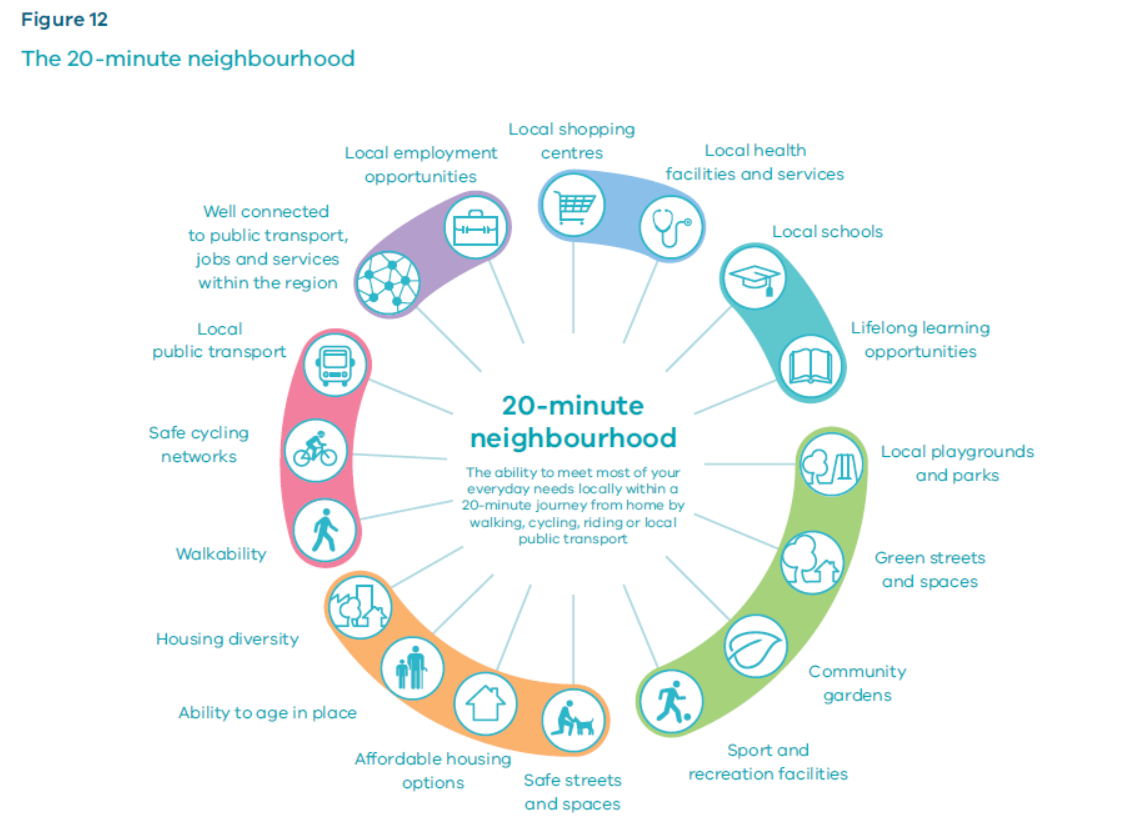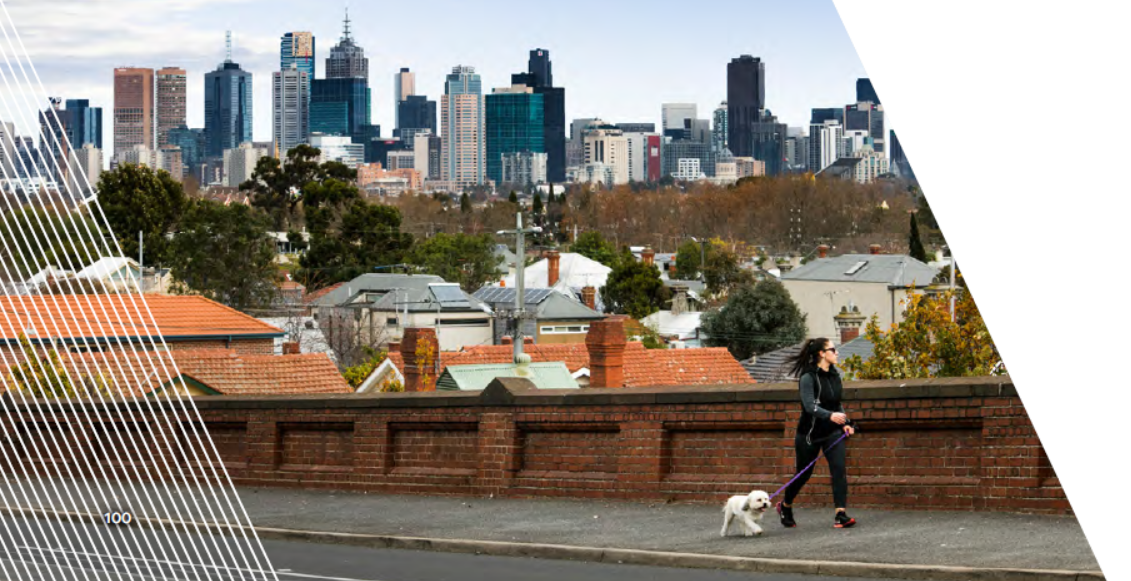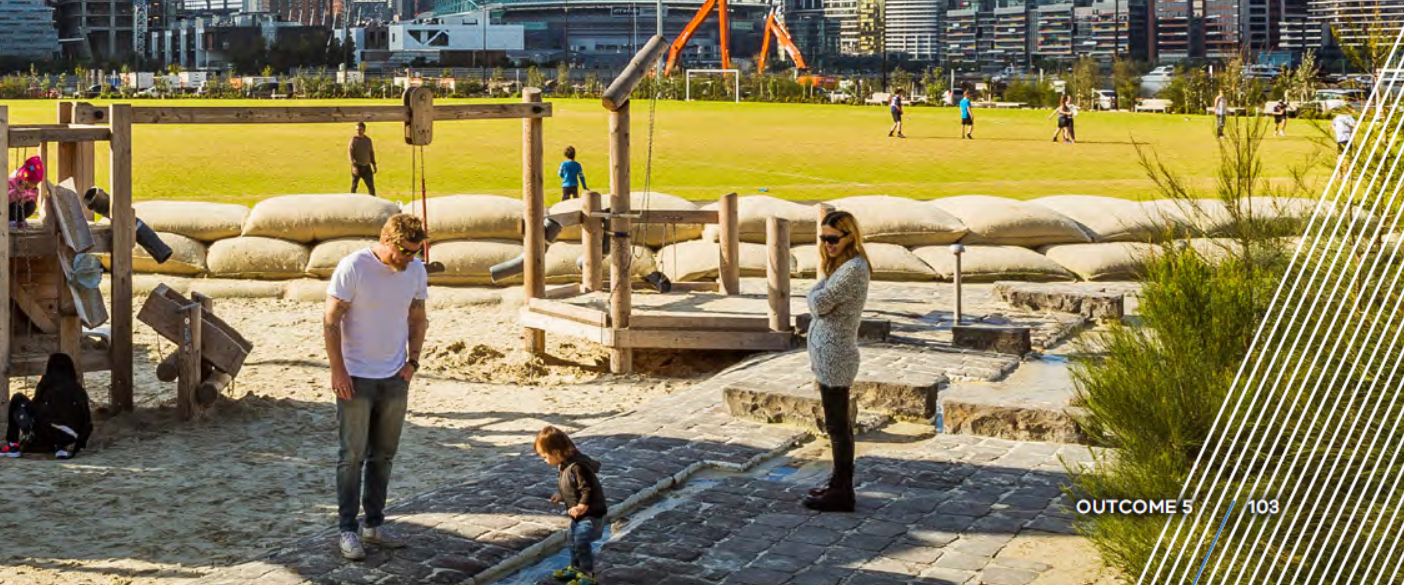OUTCOME 5
Melbourne is a city of inclusive, vibrant and healthy neighbourhoods
Melbourne has always been a city of neighbourhoods ever since the days of Little Lon and the establishment of the city’s first suburb, Fitzroy.

Melbourne’s Plan
Create a city of 20-minute neighbourhoods
Research undertaken by the Heart Foundation (Victoria) for the Victorian Government identifies hallmarks of a 20-minute neighbourhood.
A 20-minute neighbourhood must:
• be safe, accessible and well connected for pedestrians and cyclists to optimise active transport
• offer high-quality public realm and open space
• provide services and destinations that support local living
• facilitate access to quality public transport that connects people to jobs and higher-order services
• deliver housing/population at densities that make local services and transport viable
• facilitate thriving local economies.
The 20-minute neighbourhood is all about ‘living locally’— giving people the ability to meet most of their everyday needs within a 20-minute walk, cycle or local public transport trip of their home. If 20-minute neighbourhoods existed across Melbourne, it could reduce travel by nine million passenger kilometres and cut Melbourne’s daily greenhouse gas emissions by more than 370,000 tonnes.

Create neighbourhoods that support safe communities and healthy lifestyles
Increasingly, councils are taking a whole-of-population approach to health planning, particularly through municipal public health and wellbeing plans.
Likewise, many councils are focusing on factors that create the conditions for good health, ranging from the re-design of local neighbourhood parks and streets through to the development of new neighbourhoods and town centres. These include applying Crime Prevention Through Environmental Design (CPTED) principles in the design of public spaces.
Urban renewal precincts, greyfield redevelopment areas and transit-oriented development areas (such as railway stations) are enablers in the development of an integrated transport system. Well-designed infrastructure for walking and cycling are critical elements.
The Victorian Government will work with local governments and other stakeholders to create neighbourhoods that support safe and healthy communities.

Deliver social infrastructure to support strong communities
It takes more than good land-use and transport planning to build good neighbourhoods. The economic and social benefits of providing social infrastructure can outweigh the costs of provision and result in a positive net return on investment.35 Social infrastructure encompasses all the facilities, services and networks that help families, groups and communities to meet their social, health, education, cultural and community needs. Space and resources are also needed for community meeting places, learning centres, neighbourhood houses, volunteer centres and welfare providers.
Social infrastructure should be designed to be accessible to all members of the community and, in growth areas, must be delivered early. Both the public and private sectors have key roles to play in this, as well as in the operation and maintenance of community facilities. In some cases there may be opportunities to make the most of existing public facilities, such as using school buildings outside school hours and co-locating aged-care and childcare centres.
Early provision of active open space and sports fields in neighbourhoods supports healthy communities. Some recreational and cultural facilities need to be provided in locations that service multiple neighbourhoods to optimise the value of investment and maximise accessibility to communities.
Many social services are delivered by not-for-profit organisations, which can find it hard to secure affordable floor spaces in new suburbs.
Cemeteries and crematoria need to be provided in sensitively chosen locations. It is important to cater for all faiths when planning for cemeteries and crematoria. The requirement for additional burial spaces needs to be reviewed on a regular basis.

Deliver local parks and green neighbourhoods in collaboration with communities
Greening Melbourne’s neighbourhoods enhances beauty and amenity and provides more places where people can meet, exercise and relax. They give city dwellers a chance to enjoy natural environments, support biodiversity, and improve the quality of air, water and soil.
Residents should be included in community landscaping and revegetation opportunities such as community gardens, vegetable patches, play areas for children and greening streetscapes with tree planting and nature strip gardens. Communities can also convert disused public land into parkland to green their neighbourhoods and increase public open space.
